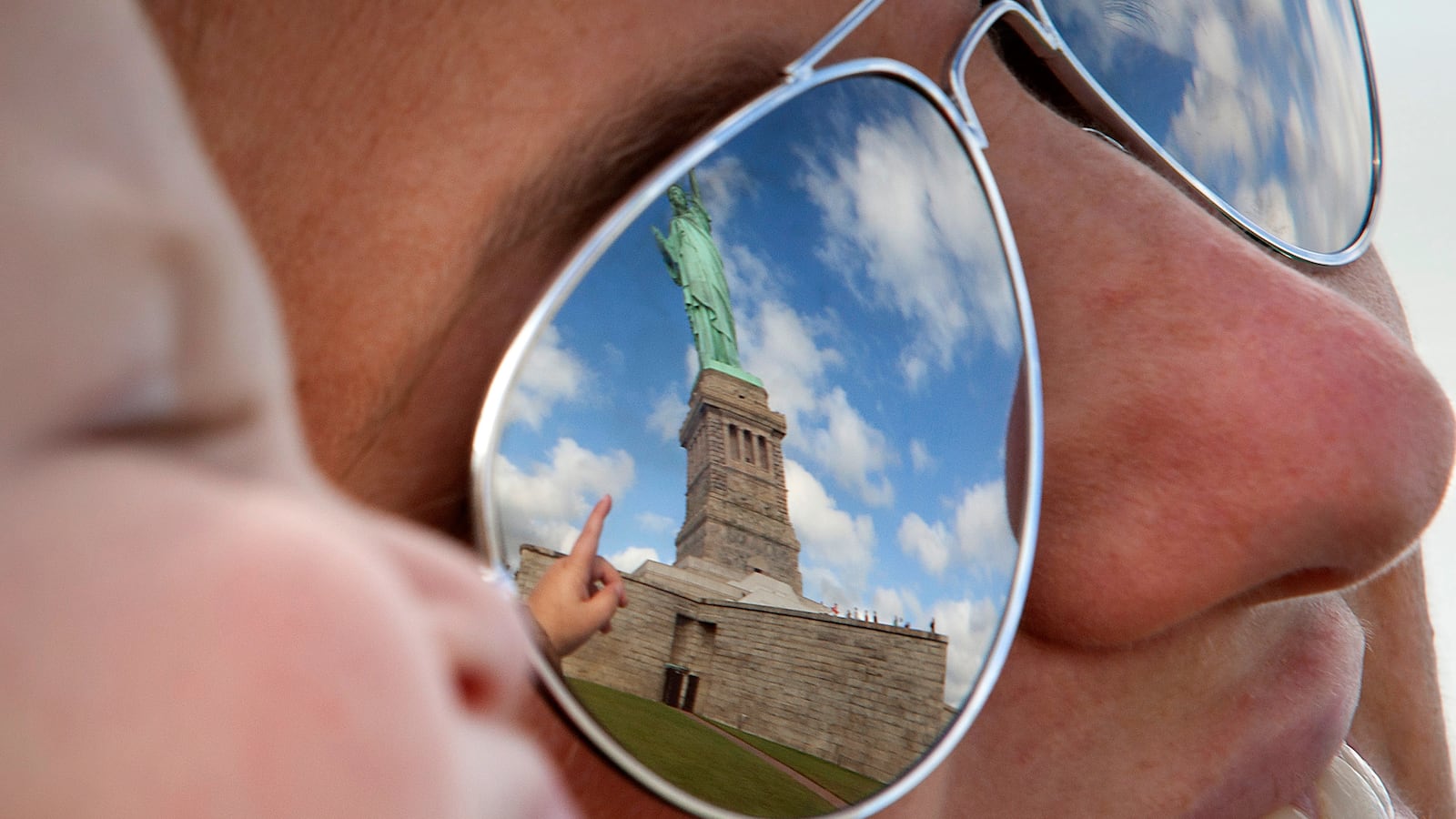One hundred and twenty eight years ago today, New Yorkers gathered as one for a city-wide party. Hordes of celebrants, swept by rain, surged over the five-year-old Brooklyn Bridge. They positioned themselves along the window ledges of Fifth Avenue and curled at the tops of light posts, so they could witness a parade of 30,000 marchers tromping through the gray.
Visitors from beyond the tentacles of the urban streets—from New Jersey or Connecticut—joined the million people gathered in the avenues of Manhattan. Almost every worker had been given the day off. Those who hadn’t still celebrated: traders on Wall Street invented a new tradition when they hurled ticker tapes from their windows, snowing the unspooling white ribbons on their fellow citizens below.
That October 28 event wasn’t segmented for a particular constituency—not for West Indians or the St. Patrick’s day Irish, or fans of the New York Giants. All Americans were included because the huzzahs focused on a treasure said to be held by every citizen: Liberty.
The151-foot newborn waited in the harbor on her 171-foot pedestal, a huge French flag fluttering over her dark copper face. On the mainland, on the grandstand for the parade, and later up in the viewing room in her head as the dedication began, was the 52-year-old Frenchman, Frédéric Auguste Bartholdi, who had dreamed of this colossus almost two decades earlier, had pitched her to a disinterested public, and finally had drummed up cash in France and America to get her built.
He hadn’t thought first of America for his work. He had aspired to construct an epic figure after visiting the pyramids and sphinxes of Egypt in 1855. He was awed by these massive structures, which, privileged by their size, seemed almost eternal—too big to entirely crumble quickly, too awesome to be razed. He first pitched his idea of a female harbor colossus to Egypt but the deal fell through. He then bided his time until he could hit on justification for the creation’s scale, and he found it in the championing of Liberty, a treasure elusive to his own French people, but nurtured in America.
When he brought the idea of the colossus to America, the Civil War had ended just six years earlier. A foreigner such as Bartholdi viewed the abolition of slavery as Liberty achieved in the United States. France roiled with the battle between the left wing Communards and the Versailles government, culminating in “Bloody Week” just days before Bartholdi’s journey here, with 10,000 dead in the Paris streets. To Bartholdi, his statue meant a commemoration of Liberty attained. It would mark the fact that France had helped America win that liberty almost a century before.
Americans, on the other hand, did not fully understand the nature of this gift. They were swept up in the economic surge of life after the Civil War. Bartholdi’s Liberty statue proposal had at first bewildered them. Many of them became hostile as the project moved closer to reality, but finally huge numbers of them were convinced to ante up their own pennies toward the statue’s completion at the urging of newspaper magnate Joseph Pulitzer, primarily as a way to get their names in the newspaper on a donor list. Their excitement that late October day had more to do with their thrill of the day off from work, at the pageantry of the parades in Liberty’s honor on land and sea, the visit of the president of the United States for the event, and the interest in seeing a Wonder of the World in their midst.
Unfortunately, fog thickened. They peered out into the gloom from Battery Park and could not make out her form. Nonetheless, they celebrated.
In the intervening years, the Statue of Liberty could have lost her luster, as she indeed lost her copper color to a patina of green and long ago ceded her status as the tallest structure in New York. By any rational measure, Liberty, literally overshadowed many times over, should have lost her power to grab our attention and inspire us.
But what Bartholdi did back in 1871 when he first came to pitch his idea to America was make Bedloe’s Island, a former oyster bed, home to America’s core promise. If the nation were indeed founded on Life, Liberty, and the Pursuit of Happiness, let America be “pinged” on that notion every day. Passersby, not limited by demographics, would see her. The statue would be called by a title that induced a mantra: Liberty Enlightening the World, shortened down to “The Statue of Liberty.” People would be forced to say the word “Liberty” on a regular basis. Bartholdi would lose his own fame but that word, “Liberty,” would echo on, from every tour bus operator, from every child pointing out a car window, from every mind that glimpsed the iconic image on billboards or print ads.
Even that day of the unveiling, Liberty remained elusive in practice in the United States. Suffragettes were forced to circle the island on a boat as only two women had been allowed to witness the formal ceremonies; they would protest that treatment along with the lack of liberty to vote. A writer would note that black men were still being lynched in the United States; liberty denied there, too.
But even amid those early protests, the Statue of Liberty was doing her job. If we declared we believed in that value, and we had the largest statue in the world to remind us of that fact, shouldn’t we be doing more to keep the value? The Statue of Liberty would serve as the north star of our behavior.
And what if she had never been built? What if that island were still just a home to a military fort? Without that statue, we as a country would find our concrete expression only in a flag and a brilliant Declaration that gains our attention a few times in classrooms and importantly in Supreme Court cases. We would lack a human face as our symbol; we would exist in the ether of ideas with no concrete stake in the ground to tether us. Bartholdi cherished and valued the physical world, as he made quite clear in his letters and diaries. He understood its power. And he used that resource to its fullest 128 years ago this week. Every time we see her, we must recall: Oh, yes. That is what we are supposed to be.
Elizabeth Mitchell is the author of Liberty’s Torch: The Great Adventure to Build the Statue of Liberty (Atlantic Monthly Press).






